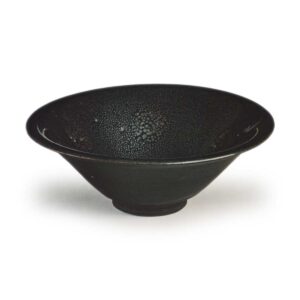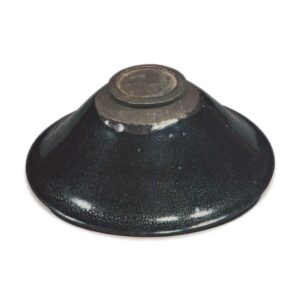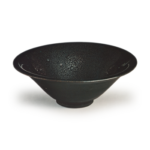

Height: 6.8cm
Diameter: 18.7cm
Outer diameter of foot: 5.8cm
Height of foot: 0.7cm
This is a rare example of a representative piece of oil-drop ware from the North China region that has been handed down in Japan.
It has a low, large, and sturdy foot with a bowl shape with a narrowing waist and a slightly upturned rim.
The bowl is rather thick and sturdy, and the mouth is particularly plump and rounded.
With the exception of the lower part of the bowl, it is covered in a thick layer of jet-black glaze, and fine oil droplets can be seen all over the surface.
The oil droplets are evenly distributed across the entire surface, and each one is a certain distance away from the others, with no areas where they are clustered together or spaced apart. However, there are five places on the inside of the body where large oil droplets have gathered together to form a circle, creating a unique design. This so-called circle of oil droplets is arranged correctly in the five places on the inside, and the glazed surface in those areas is raised, suggesting that it was created intentionally. In this way, the intentional creation of oil spots is a characteristic of Northern China oil spots, as opposed to the accidental oil spots of Southern China, and this tea bowl is a truly typical example of this.
The clay is fine and hard, but the unglazed parts are covered with a dark brown glaze, so the original color of the clay is not visible. This is a technique often seen in Northern Chinese Tenmoku. The astringent glaze is purple-brown in color, and since part of it is on top of the black glaze, it is likely that the clay slurry with a high iron content was applied after glazing.
This technique is generally understood to be a copy of the ash-black, unglazed parts of Tensan ware. The countless silver oil spots on the jet-black glaze are like looking at a sky full of stars, and have an endless appeal. Moreover, there are small, almost circular, blue-glowing patterns floating between the oil spots in several places inside and out, adding even more variety. These are less lustrous and more diffuse in shape than the oil spots, but it seems that a phenomenon similar to yohen may have occurred there.
The oil spots on the inside and rim are slightly larger. Also, the spots on the outside are smaller than those on the inside. These variations also have a natural beauty.
It is said that it was made in the Tai-gu kiln in Shanxi Province, somewhere in North China, but recently there have been reports that Yuteki Tenmoku has also been discovered in the Lushan Dantian kiln in Henan Province. The shape of the piece suggests that it was made around the 13th century.
It was passed down for a long time in the storehouse of a certain feudal lord in Kyushu, and it was kept in an old paulownia box, and on the lid of the box there is a “yuteki” written in ink. There is also an old paper used to cover the box, so there is no doubt that it is an item that has been passed down through the ages.
(Hasebe Raku)








